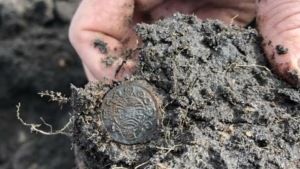News
News in Digest: In Denmark, bog-standard is as good as new
This article is more than 7 years old.
The discovery of 248 Viking Age coins in tip-top condition is a find as extraordinary as the Tollund Man

It was the coin they discovered, not the finger! (photo: Museum of Southwest Jutland)
It’s highly unlikely that they’ll find Jimmy Hoffa in a bog centuries from now. But if they do, he’ll most likely be perfectly preserved.
The anaerobic environment of a bog, and its high concentration of tannic acids, means organic material can remain unchanged for millennia.
Bodies over a thousand years old have been found with their hair, organs, and skin all intact. In Denmark, the Haraldskær Woman and Tollund Man are two such examples.
Viking card winnings?
And the same is true of coins, apparently. A cache of 248 minted over 1,000 years ago was recently discovered in Ribe in west Jutland, and thanks to their bog dwelling they look like they were produced yesterday.
Minted in the early 9th century, the dawn of Viking dominance in northern Europe, only ten such coins have been found worldwide until now, according to Claus Feveile, the curator of the Museum of Southwest Jutland.
“This is an exceptional find that represents a quantum leap in our understanding of minting. They are Danish coins and clearly minted for the purpose of being implemented in Ribe,” Feveile told DR.
“This completely shifts our understanding of how we used to mint and the process of coin production.”
Boys of the Black Stuff
In related news, Swedish archaeologists have put forward a theory that the secret behind the success of the Vikings since the early 900s was their production of tar on an industrial scale, reports Videnskab.dk.
A number of large depressions found in Sweden in connection with roadworks have been investigated, and it has been established they date back to 680-900 and were used to produce large quantities of tar.
Viking ships needed tar to make them watertight, and according to the archaeologists, some of the depressions could hold up to 300 litres, which would have been enough to caulk a whole fleet of ships.
Fluent in Argentina
Danes were still travelling in heavy numbers almost a millennium later, and a University of Copenhagen linguistic research project, ‘Danish voices in the Americas’, reveals that the descendants of emigrants to Argentina around 125 years ago are still able to speak almost fluent Danish.
In contrast, Danes who moved to the US lost their ability to speak Danish over the course of one or two generations, but similar results to those observed in Argentina were also found in Canada.
In Canada and Argentina, the immigrants lived in small local societies often centred around the Protestant Church, and it is believed that gave them a cohesion and social network that made speaking Danish relevant.
Nazi list published
In other history news, the association of Danish genealogical researchers, Danske Slægtsforskere, has published part of the so-called Bovrup Archive – a 1940s list of the members of the DNSAP, the Danish Nazi Party.
However, 22,000 names have already been lost to history, and only 5,265 names from the archive will be made public at this time – individuals who have been dead for at least a decade.
Up until now, it’s been next to impossible to establish who was a member, as all of the reliable membership lists had long gone out of print.
The Bovrup Archive was started by party leader Frits Clausen, a native of Bovrup, and in 1945 it was copied and published in book form by members of the Danish Resistance who were angry that a lot of ex-Nazis seemed to have escaped punishment.










































